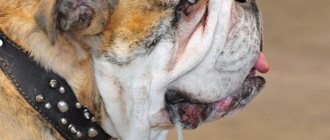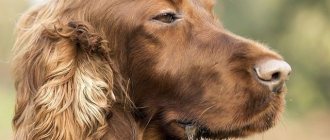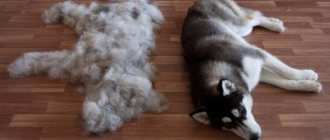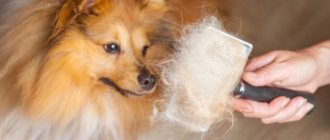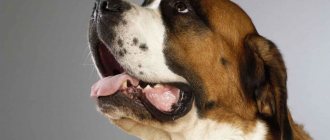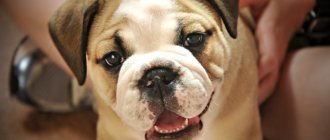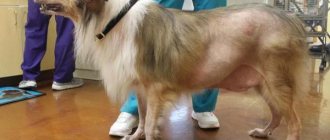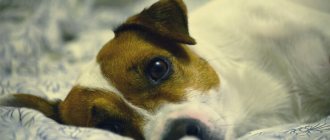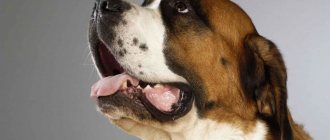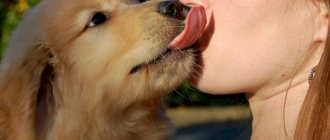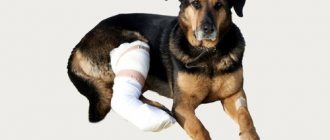Man's best friends are a lot of love, emotions, fur and drool. Saliva is a natural fluid secreted by the body of all mammals. It is needed to create a protective barrier, moisturize the mouth, and the process of food absorption. For some reason, dog saliva is credited with incredibly effective healing properties that can almost heal complex wounds.
The norm is:
- an abundance of saliva on a hot day (protecting the dog’s body from overheating),
- while walking in the cold,
- during heat (or if the male “senses” the female),
- under intense load,
- before feeding (reaction to the smell of food),
- after drug intervention.
No matter how much people love dogs, it happens that excessive salivation poisons the life of the owners, and sometimes signals health problems in the pet.
Breeds Prone to Drooling
The champions in saliva production are dogs that have large, yet shortened muzzles, with jowls hanging down the sides. They produce saliva in hot weather, at the sight of a bowl of aromatic food, and during sleep. The smell of food is the main stimulant for the production of saliva; a hungry dog, sensing food, often involuntarily “floods” with streams.
The “drool” list includes:
- shar pei,
- bloodhounds,
- boxers.
The large breeds it contains are:
- Caucasian Shepherd Dogs,
- Saint Bernards,
- mastiffs,
- Newfoundlands.
Modern representatives of these species suffer less from excess saliva, but still, when choosing a pet, you need to pay attention to this unpleasant fact. How to do it? Observe the parents for some time; salivation will appear during the meeting of the owner, during feeding, and even during temperature changes.
It happens that saliva is released during sleep in such quantities that wet spots remain on the bed.
During the heat, salivation can be so profuse that the muzzle becomes covered with foam, and streams of water simply flow from the tongue. Wipes, a bowl of water and all available methods of cooling your pet will help here. But in all other cases, abundant and seemingly causeless increased salivation should cause alarm among the owners.
Treatment method and prognosis
There is no single treatment regimen for hypersalivation. After identifying the cause that caused the excessive secretion of saliva, the doctor develops it on an individual basis, based on the diagnosis, the animal’s health condition, age, etc.
For dental diseases and tumors, teeth cleaning and surgery are used. Removal of a foreign body, if the owner could not get it at home, may require the use of anesthesia and sedation. Antibiotics and antiviral drugs are used to treat oral infections and inflammatory diseases.
If a dog's drooling is accompanied by nausea and vomiting, it is prescribed maintenance therapy with adjustments to nutrition and fluid administration.
As for the prognosis, it all depends on the root cause. If hypersalivation was caused by a dangerous disease such as rabies, which cannot be treated, then the prognosis is unfavorable.
Pathologies of the oral cavity
A sudden increase in salivation may indicate a disease in the dog's mouth or a foreign body entering it. An object stuck between teeth or embedded in the gum may be indicated by a small amount of blood mixed with saliva. This could be a splinter of a bone caught in food, a pebble or a twig picked up during a game.
An indirect sign of a problem is that the dog shakes its head, whines, tries to remove an interfering object from its mouth with its paw, and does not allow one to touch its muzzle. The foreign object must be removed from the mouth as quickly as possible, and the damaged area must be treated with any disinfectant. If the object is deeply embedded, inflammation or an abscess is discovered, the animal must be taken to a specialist as quickly as possible.
The second problem with excessive saliva in the mouth is problems with teeth. Yes, contrary to popular belief, a person’s friends also suffer from caries, gingivitis, and tartar. Dental problems manifest themselves in swelling on the face, noticeable during a visual examination of the mouth, and the disease can be guessed by the unpleasant odor emanating from the pet. In this case, only a veterinarian can solve the problem.
Sometimes saliva appears due to an incorrect bite, which prevents the dog from eating food normally. Bitches with hormonal imbalance or an analogue of toxicosis that occurs during pregnancy immediately after mating sometimes suffer from the same problem.
Diagnostics in a veterinary clinic
When contacting a specialist, the owner must tell in detail about the dog’s lifestyle, peculiarities of keeping and feeding, contacts with other animals, medications used recently, and other symptoms. The veterinarian’s task is to differentiate normal drooling from salivation, accompanied by gagging and smacking.
To diagnose the disease, the veterinarian will conduct a complete neurological and physical examination of the animal (special attention to the oral cavity and neck area) and diagnostic tests, including a complete blood count (general, biochemical), urine tests, stool tests, ultrasound, x-rays, biopsy ( if a disorder of the immune system is suspected), washings from the mucous membranes.
Infections caused by viruses
Every pet can get sick; fever, dry nose, refusal to eat, increased thirst, apathy are reasons to consult a specialist. And an increased amount of drool may indicate a viral disease contracted by the dog.
The list of viral diseases carried by animals includes:
- carnivore plague,
- hepatitis,
- enteritis,
- tracheobronchitis,
- parainfluenza
All these diseases can be treated exclusively in a veterinary hospital.
What to do at home
The first thing an owner should do if they notice unusual drooling in their pet is to carefully examine the oral cavity. There may be a foreign body stuck there that needs to be removed. If a wound has formed in your mouth, it should be disinfected. A veterinarian's help may only be required if the wound becomes suppurated.
If a dog drools profusely before eating or after excessive exercise, the owner does not need to do anything. As soon as the pet eats or calms down, the process of copious salivation will stop.
If you experience stress caused by traveling in a car, you need to train your dog to travel. It is better to start with small distances, gradually increasing them. This trains the animal's vestibular apparatus. Over time, your four-legged pet will understand that traveling in a car does not threaten him with anything terrible.
It happens that a dog gets very nervous at shows. In such cases, it is advisable to walk him more often, introduce him to other people and animals, and change the environment. It is advisable to seek the help of a dog handler. If the situation is severe, the veterinarian may prescribe sedatives, homeopathic remedies, and herbal decoctions.
If the owner is sure that the dog has been poisoned, he can provide first aid to it using products intended for humans. Activated carbon and Enterosgel are suitable. However, if the symptoms of poisoning do not go away, it is necessary to show the animal to a veterinarian.
Small puppies are always gnawing on something during the period of changing teeth, as a result of which saliva constantly flows from their mouths. No worries. This is a normal physiological phenomenon. When baby teeth are replaced by molars and the gums stop bothering the baby, excessive salivation will stop. The only thing the owner can do to help the puppy is to provide him with as many toys as possible that he can chew.
Chronic illnesses
Like humans, our furry friends also suffer from chronic diseases, some of which cause increased thirst, causing the dog to increase water intake and, as a result, produce more saliva. Excessive salivation signals an exacerbation of a chronic disease:
- gastrointestinal tract (ulcers, gastritis may occur),
- liver
- gallbladder.
Sometimes a similar symptom occurs in bitches suffering from false pregnancy.
Causes of increased drooling
It is important for owners of four-legged pets to know what reasons can cause excessive salivation in a dog. Such knowledge will help determine the need for emergency hospitalization or the admissibility of providing first aid at home. There are physiological and pathological options for increasing the amount of discharge. The features of the first category were discussed above, now it’s time to consider the reasons why drooling increases in dogs with liver disease and other diseases. In the voiced variations, age does not play a role, therefore pathology can manifest itself in puppies and adults.
Poisoning
Most often, an abundance of saliva occurs when the body is poisoned. And this is not necessarily low-quality food; it is enough to “overload” the stomach with your pet’s favorite dish or give it chocolate, specific fruits, or even fatty pork that is harmful to dogs.
Saliva may appear as a reaction to contact with household chemicals or poisons used in the household. Once in the body, they cause nausea, accompanied by vomiting and severe salivation.
In such a situation, it is necessary to rinse the stomach; this can be done with a large enema with water, forcing the pet to drink a lot of liquid, causing a gag reflex. After the water coming out becomes clean, you can feed the coal, energy gel (putting it on the root of the tongue), and give the animal a rest.
In case of relapse or poisoning, immediately take it to a veterinary clinic.
Causes of increased salivation in dogs
Four-legged pets fill the house with joy, cheerful barking, and fun.
It is not uncommon for all surfaces of the house to become covered in dog saliva. Household members may not like this fact, but animal lovers cannot escape it. But sometimes such a physiological manifestation can seriously frighten the owner. We are talking about excessive salivation or sialorrhea, ptyalism, hypersalivation in domestic dogs. Increased saliva production is a concern. This is quite reasonable, because it is directly related to changes and pathologies in the body of the tailed friend. Why does a dog's mouth drool? We'll talk about this next. We will definitely dwell on the concept of the norm, reasons, actions of the owner and the preventive program.
Stressful situations
Excessive saliva manifests itself as a reaction associated with the animal’s psyche, most often due to stress experienced. In this case, the animal may develop a tic, its jaw will twitch nervously, churning saliva into a copious foam.
This may be caused by:
- departure of the owners who left the pet with strangers,
- change of place of residence,
- a fight provoked by another animal,
- excessive zeal in training,
- the appearance of a “competitor” in the person of a newborn,
- constant punishment from the owners.
In this case, it is necessary to resolve the issue by obtaining recommendations from a veterinarian; most likely, they will prescribe sedatives. You can offer your pet a treat or take it with you for a long walk. Just give him maximum attention, show that everyone still loves him. After returning home, you need to pay attention to the dog for several days.
Travel can sometimes be stressful, but most dogs still love to travel with their owners. But if, nevertheless, the animal is frightened, it is necessary to give sedatives, stroke it, and, if possible, take the pet in your arms. When motion sickness occurs, you need to train the dog, gradually accustoming it to transport or pre-administering special medications.
Traveling with a slobbering dog is not the most pleasant situation; here you need to stock up on bibs, absorbent diapers and napkins. If the cabin is hot, then there will definitely be saliva; here, if possible, you need to turn on the air conditioning or provide access to cool air. As an option, stop more often to allow your pet to catch its breath.
Occasionally, the cause of stress, the consequence of which is drooling, is caused by the close presence of a female dog in heat; this is a normal reaction for a mature male.
Drooling while traveling
Not all four-legged pets easily tolerate riding in a car or other transport, even over short distances. Often this process is accompanied by stress and psycho-emotional complications.
The causes of increased salivation in dogs mentioned above are related to each other. Some tailed friends get motion sickness while traveling by car due to imperfections in the vestibular system.
The clinical picture of this condition is represented by depression, rapid breathing, excessive salivation in combination with foam, nausea and vomiting. In most cases, this goes away as the animal matures. As a rule, adult individuals no longer experience such ailment. For prevention, you can take special medications. Only a veterinarian can prescribe medications after examining the pet’s health condition.
Symptoms of ptyalism
How to understand whether the salivary glands are working excessively or normally, especially when it comes to a child? What should you pay attention to?
If a child has a constantly wet chin, clothes on the chest or in the collar area, then we can talk about drooling. But it is important to find out its cause. Perhaps the baby is simply engrossed in the game and does not notice that his mouth is watering. Then you need to teach him to control his condition; there are different methods for this.
Attention! With intense drooling, the child does not have time to swallow the resulting oral fluid, and it flows out of the mouth. This leads to maceration of the skin in the area of the chin and lower third of the cheeks, and sometimes the neck. In addition, frequent drying also injures the skin, making it defenseless against various types of bacteria. Then, against the background of ptyalism, a secondary infection develops, which is expressed in redness and peeling of the skin, the formation of a rash and ulcers.
It is also worth paying attention to how a person swallows: does this process occur automatically, or does the patient have to make additional efforts (stretch the neck, move the shoulders, strain the facial muscles, etc.) - then we are talking about false hypersalivation.
Another sign of ptyalism may be constantly wet lips and splashing saliva during a conversation.
Liquid yellow vomit
The dog is vomiting yellow liquid - the yellow tint of the mass indicates that the dog is vomiting bile. If the dog itself decided to cleanse its stomach (for example, it ate grass on an empty stomach, as described above), then there is nothing to worry about. If you see such vomiting “out of the blue” or very often, then it may be that:
- the dog eats low-quality food that contains preservatives, or is malnourished;
- the animal has contracted worms;
- gastritis or stomach ulcer begins;
- The dog has liver problems.
Normal saliva volume
Saliva in dogs is a colorless liquid that is produced by the salivary glands (parotid, zygomatic, sublingual and submandibular). It moistens the mouth, glues the chewed food together and makes it easier to swallow. In addition, this liquid helps cleanse the oral cavity, as it has a bactericidal effect.
On average, a medium-sized dog produces about 1 liter of saliva per day. This numerical value is considered normal. The animal may produce more saliva. For example, this happens when eating dry food. They cause increased salivation. However, there may be another reason.
